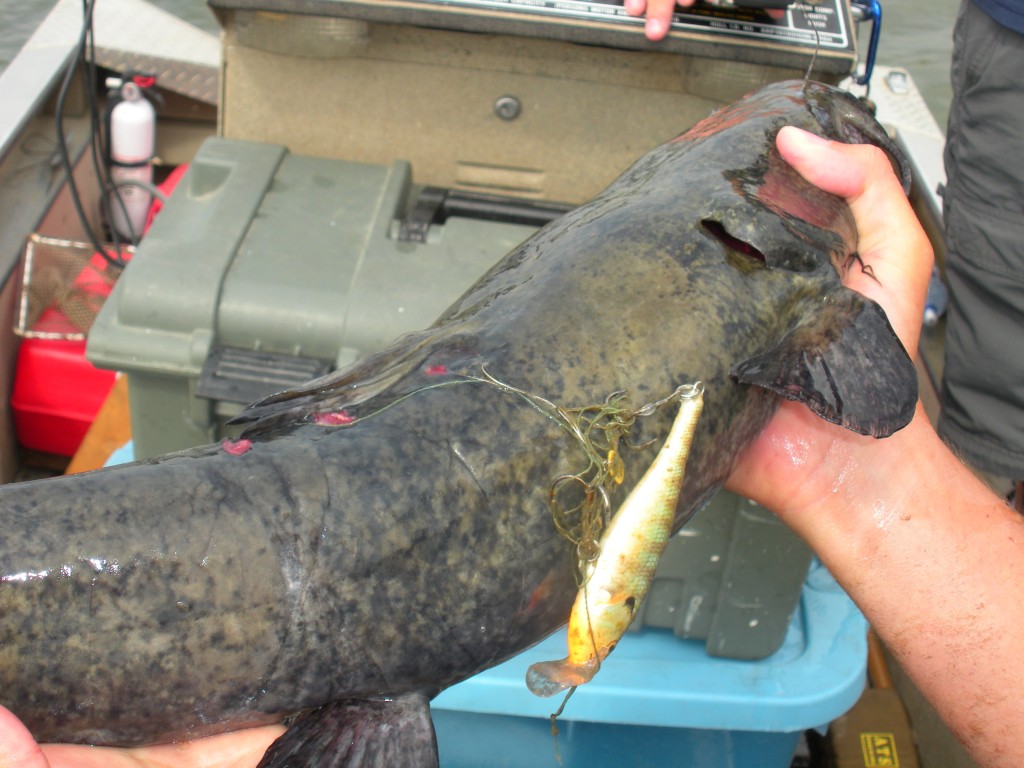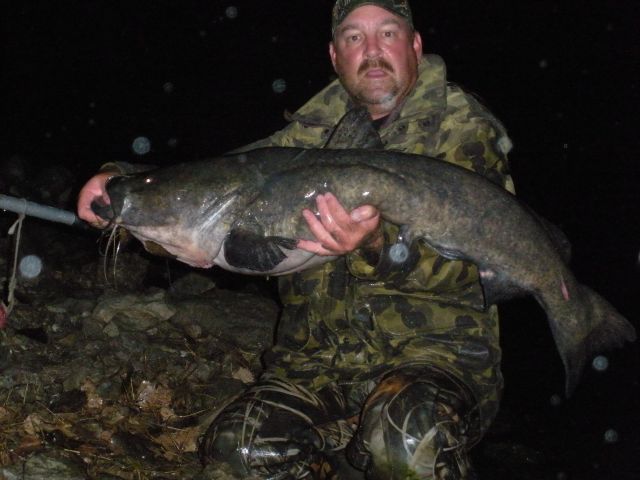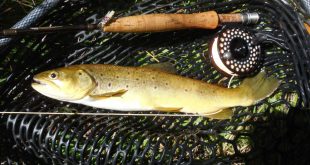I slipped out of the office one day last week and helped some of our field biologists do some flathead catfish collecting at Branched Oak Reservoir.
Got your attention now?
I have blogged about this fisheries project at Branched Oak before and am not going to repeat all of that again here. What I would like to do in this blog post is share some of the things that have been learned about those big, beautiful flatties in Branched Oak.
“Tag, you’re it”
We believe we have an unique and special flathead catfish fishery in Branched Oak, especially for a reservoir fishery, and wanted to learn more about it. Starting in 2010 fisheries biologists began putting tags in Branched Oak flathead catfish larger than 10 inches. If you want to know the “nuts and bolts” about how the fish are captured and tagged, please go back and read this blog post, http://magazine.outdoornebraska.gov/2010/08/flathead-tagging/ . Nearly 1400 flathead catfish in Branched Oak have been tagged since 2010. That work started in the summer of 2010 and has been continued on a weekly basis throughout the summers of 2011-2012. It will continue on a weekly basis this summer as well.
One thing fisheries biologists can do by marking or tagging fish is calculate an estimate of the actual numbers of fish in that population. Most of the fish sampling done by fisheries biologists produces an index, a relative abundance of fish present, but does NOT produce numbers that state there are X number of fish present in Lake Y. Marking or tagging projects are more labor-intensive and cannot be done on every body of water, but at times, during special projects, that fisheries management work is done and that data is collected.
Now there are a lot of formulae, math and statistics involved in calculating population estimates and there is no way I could explain all of that here even if I understood it. So, let me just give you the bottom line: We believe there are approximately 4,500 flathead catfish larger than 10 inches in Branched Oak Reservoir; that would work out to about 2.5 flathead catfish per every acre of water. About 1,050 of those fish would be larger than 34 inches.
We know that flathead catfish in Branched Oak are very successful at reproducing on their own, but we do not have estimates on the numbers of fish less than 10 inches present. I would tell you that it is plenty. For a few years, several years ago, small flatheads were stocked in Branched Oak to bolster the population and the adipose fins on those fish were clipped. From 16-24% of the flathead catfish sampled in each of the past 3 years have clipped adipose fins, so those stocked fish are still contributing to the population, but all of the small fish present now are products of natural reproduction.
Let me comment on the number of flatheads > 34 inches, 1,050, and put a little perspective on it. At full pool, right now, Branched Oak Reservoir has about 1,800 acres of water. That means there is less than one big, 34-inch or larger, flathead catfish per acre. Most of you know that all flathead catfish caught at Branched Oak must be released immediately and you might conclude with no harvest there might be more big flathead catfish out there. I believe we have about as high a density of large flatheads in Branched Oak as you can have in a reservoir, and at that there is still less than one big flathead per acre. Keep in mind that flathead catfish are predators, the biggest, baddest predators that swim in many Nebraska waters. As such, any body of water can support only so many of those big, apex, predator fish.
Again let me crawl up on my catch & release “soapbox” for a moment. There are only a little more than 1,000 big flatheads in Branched Oak even with a total catch & release regulation. With the relatively slow growth rate of flathead catfish in a northern state like Nebraska, it takes several years to grow flatties larger than 34 inches, dozens of years (we eventually will have more age & growth information on Branched Oak flatheads). Imagine how many fewer of those fish would be present if we allowed ANY harvest. You have probably heard me say it before, I will say it again now: Big fish are hard to catch NOT because they are smart, but because they are rare.
Catch & release works! We have had tag numbers reported from 40 tagged flatheads that have been caught & released at Branched Oak since 2010. The numbers of those tag returns has increased each year as more fish were tagged and anglers were more aware of reporting their catches of tagged fish. Two of those tagged flatheads have been caught and released by anglers multiple times. One was caught twice by two different anglers while another has been caught & released three times by the same angler!!!! (That angler shall remain nameless, but I believe he and the fish are on a first-name basis, and the fish believes his angler-friend probably spends too much time at Branched Oak fishing–Ha!)
Back in 2001 researchers from the University of Nebraska tagged some flathead catfish at Branched Oak. One of those fish was recaptured by an angler in 2012. In 2001 when it was originally tagged it was 18.5 inches long; when it was recaptured in 2012, its weight was estimated at 20-25 pounds–a fish of probably about 35 inches.
Flatheads in Branched Oak are very healthy or “fat” for their size. The weights of all sizes of flatheads that have been collected from Branched Oak have been near average. Larger flatheads tend to be even “fatter” for their size and weigh more than average. Those “relative weights” would be indicative of a predator population that is finding plenty of prey to eat, and prey of a variety of sizes.
“They are where you find ’em”
Another reason fisheries biologists wanted to do extra research on the flathead catfish in Branched Oak Reservoir was to better understand the habitat those fish are using in a reservoir environment. Most of that information has been collected by electrofishing flatheads all around the reservoir and keeping track of the catch rates on different habitat types. Flatheads in Branched Oak definitely have a preference for certain habitats. Rocky substrates on breakwater jetties and the dam are heavily used by Branched Oak flatheads, but those habitats are used primarily by flatheads less than 20 inches long. Fish larger than 20 inches definitely show a preference for woody habitats, both old standing timber present since the reservoir was built and new-growth flooded timber present in the reservoir over the past few years. The “A-Jack” offshore breakwaters found around the reservoir tend to offer a blend of both the rocky and woody habitats and are heavily used by all sizes of flatheads.
Now I know there are some of you hard-core anglers reading this and you are jumping to some conclusions about the location of flathead catfish in Branched Oak. So, let me put some perspective on that data. As I said that habitat use information comes mostly from sampling a variety of habitats and keeping track of the number of fish sampled per time spent sampling during summer, during the day. Flathead catfish definitely are nocturnal predators and can spend the day holding in one area before they go roaming looking for prey at night. I just stated that smaller flatheads in Branched Oak tended to use rocky habitats while larger fish preferred woody habitat of some type. Keep in mind that those fish are using those habitats during the day. Many of us know from experience that there are some big flatheads that use rocky habitats on Branched Oak after dark. However, if you are pursuing big flatheads in Branched Oak, keep in mind that those trees, all of them, are loaded with fish, and even if that is where those big flatties spend the day hanging out, they come from those areas when they get hungry and start hunting.
In addition, I am fully aware that there are a bunch of flatheads caught from Branched Oak from deeper water. We know that there are flatheads using deeper habitats, but keep in mind that the electrofishing boat we use is very effective for collecting flatheads, but it is NOT very effective for sampling deep water (deeper than about 6-8 feet). Yes, there are some big flathead catfish in Branched Oak that are using deeper water and are not being sampled. However, those fish do not sit in that deeper water all the time, and we are still collecting, and tagging, at least a portion of those fish.
“I have a radar contact”
Last year our field biologists “kicked it up a notch” and started placing radio tags in Branched Oak flatheads. Initially, those radio transmitters were surgically implanted within the body cavity of the fish.
Would you believe that did NOT work? Do not ask me how they did it, where it came out at, or anything else, but it was soon discovered that the fish that had radio transmitters surgically-implanted within their bodies somehow expelled those transmitters! Like I said, we have no idea how they did that, but apparently all of the surgically-implanted radio transmitters were expelled from the fish shortly after implantation! Field research always has its challenges!
So, back to the drawing board, our biologists had to find a new way to attach radio transmitters to Branched Oak flatheads. Basically, those transmitters have been attached the same way as the plastic tags. You can see a blog post on the radio-tagging here, http://magazine.outdoornebraska.gov/2012/06/71-6-radio-dial-all-flatheads-time/ . The radio tags have batteries in them that are guaranteed to last for 75 days. All of the radio transmitters have lasted at least that long and most have lasted up to the maximum battery life of 150 days. Tracking of the fish has been done on a weekly basis after the transmitters were attached. Fish from about 12 inches to 43.6 inches have been radio-tagged.
With the battery life of the radio transmitters, placement of transmitters on fish has been staggered; 18 flatheads in Branched Oak were radio-tagged in June of 2012 and another 7 fish were radio-tagged in September of 2012. Additional habitat use data can be gathered from the radio-tagged fish. At this point, after last years tagging and tracking, I can tell you that about half of the radio-tagged fish tended to be “homebodies” and stayed basically in the same area in which they were tagged for the duration of their radio transmitter’s battery life. Other radio-tagged fish were “roamers” and moved. Some of them moved A LOT, all over the reservoir. Those fish that roamed were hard to locate and at times they seemingly disappeared only to show up during tracking weeks later at a completely different location. These results are similar to radio-tracking results I have seen for other species of fish in a variety of environments. Other radio-tracking studies on other species have also shown “sub-populations” of homebody fish and roaming fish. Those might be different life/predatory strategies that work for different individual fish or it may be that certain fish dominate prime habitats while others roam and “fill-in” habitats as they come available or take advantage of predation opportunities as they appear.
Tracking last fall was insufficient to tell us all we wanted to know about winter habitat use of flathead catfish in Branched Oak Reservoir and we hope to learn more about that in the future. There are 20 additional flatheads ranging from 12 inches on up to 34 inches and larger in Branched Oak that received radio transmitters again last week. One of those fish was a radio-tagged fish from last year that was re-captured (I even netted it!) and had a new radio transmitter placed on it for this year.
I know some of you have been trying real hard to be the first angler to catch and release one of the radio-tagged Branched Oak flatheads. Well, let me tell a couple of stories and burst some bubbles. First of all, there was a recapture of a radio-tagged flathead from Branched Oak last summer, but we do not know if the angler that captured that fish even realized it was radio-tagged! That fish was one of the roamers I mentioned earlier and in fact was a fish that had seemingly disappeared and had not been tracked for several weeks. During that time one of our fisheries biologists received notification of a tag number of a flathead that had been caught & released at Branched Oak. The tag number corresponded to a radio-tagged fish, but the angler who reported that tag number mentioned nothing about the fish having a radio tag. We were unable to contact that angler for more information. Subsequently, that fish was finally located again and was tracked roaming around the reservoir until the battery expired.
The second capture of a radio-tagged flathead at Branched Oak occurred just last week. It occurred before the fish were radio-tagged this year, so it was a fish that had one of last year’s now dead radio tags still attached. The fellow who caught this fish was tossing jigs for crappies on one of the breakwater jetties and caught a tagged flathead. Now, the guy said he caught the catfish and “stuck it in his fish basket”–GGGGgggggrrrrrrrrrrrr!!!!!!!!! I do not know what part of total catch & release for all flathead catfish in Branched Oak this guy did not understand; putting that fish in his fish basket would have been a violation. Later, he got to looking at that flathead in his fish basket and noticed it was tagged and radio-tagged. So, he sent us the tag information and then released the fish from his fish basket. I do not know if he intended to harvest that flathead and got nervous because he thought black helicopters and black Suburbans were going to descend upon his place and agents wearing dark sunglasses and wielding radio-tracking receivers were going to track that fish and break his front door down? Whatever it was, he finally decided to release that fish.
Let me offer a couple more interesting observations before I quit rambling.
First of all, catfish are very resilient, very resistant to injuries. You all know that catfish do not have scales to protect their skin. Especially during the spawn period, you will see a lot of abrasions, cuts and injuries on adult catfish; those fish are hard on each other during the spawn. Cuts and abrasions on catfish heal rapidly. We know that catfish skin and likely the slime or mucus coat has amazing healing abilities. There has even been some work done by medical scientists to try to better understand the healing properties of catfish. I said all of that to say this, the tags and radio-tags placed on the flatheads cause little if any discomfort and typically the insertion points heal completely. However, we did recapture one tagged Branched Oak flathead last year that had some abrasion around the tagging wires. Take a look and I think you will see why:
If one of you who uses one of the “super lines” lost a #9 Shallow Shad Rap in perch pattern at Branched Oak, we have your crankbait. Apparently, that fish did not strike at the bait but was unlucky enough to have the bait become entangled in its tag. Along with the crankbait there were several feet of line attached and that extra “bird’s nest” attached to the tag was a chronic discomfort to that fish. We removed the crankbait and line, gave the fish a new tag, and sent it happily on its way.
Our fisheries biologists have handled a lot of big flatheads at Branched Oak in the past couple, three years. They have handled numbers of fish that exceeded 50 pounds in weight. I have been along during some of the flathead collecting and have seen several of those fish. On a day of sampling we will handle lots of fish over 20 pounds and on a good day a number of fish over 40 and 50 pounds. A guy’s arms hurt after lifting all of those big fish! But I have to tell you that of all the big flatheads I have seen while helping collect those fish at Branched Oak, the biggest I have handled/seen has still been this 47 inch fish I caught on hook & line!
Anglers select for big fish. Even with extensive sampling of big fish, the total population of anglers still may see more of the biggest fish in any population before pointy-headed fisheries biologists using nets or electrofishing gear see those fish (http://magazine.outdoornebraska.gov/2010/12/big/). We have seen some flatheads over 45 inches at Branched Oak, but I know there are fish even bigger than that out there.
Besides the flatheads, Branched Oak also has very healthy populations of channel and blue catfish. The electrofishing gear we use is very selective for flathead catfish, but last week while I was on the reservoir helping, I saw lots of channel cats and at least a couple dozen blue cats. All of those fish were also very healthy and the blues were all well over 20 pounds a piece. I know there are some, but there ain’t many fisheries anywhere that can offer anglers the catfish fishing that is available at Branched Oak right now–there are lots of channel cats, a high density of flatheads up to “HOLY COW” size, and blue cats too! A Branched Oak catfish slam sounds like a worthy goal–GO FISH! If you catch a tagged flathead while you are out there, you gotta release it, write the tag number down, leave the tag, and if present, radio transmitters on the fish, and let me know about it!
 Nebraskaland Magazine
Nebraskaland Magazine









